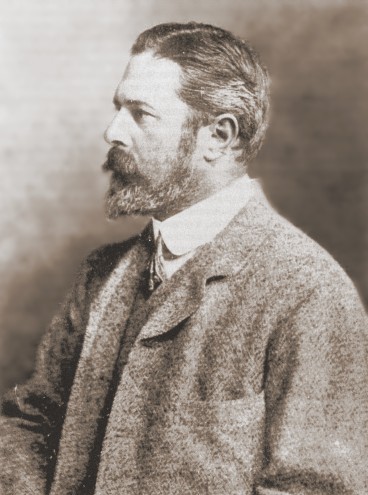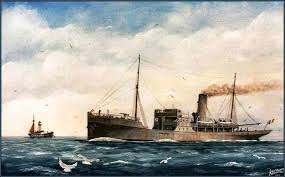
On August 4th 1911 Ernest William Lyons Holt signed a lease on the Mill House and Pleasure Gardens, coach house and coalhouse, Ballymore Eustace on a quarterly term at £25 per annum. From the attendant schedule we can see that the premises was very well furnished at that time. The house had been occupied by the last of the Copeland family, Miss Mary Copeland, up until her death in the year 1909. The Mill itself was operating at a very reduced rate. The house was on the banks of the River Liffey close to the old bridge heading south from the town. Anyone with a love of water would appreciate such a site and the soothing sound made by the flowing tide. The records of the Ballymore Anglers do not go back that far, so we don’t know if Mr Holt cast a line there for a trout or even a salmon.
Holt had led a varied life before he came to Ireland. He was born in the year 1864 in London, was educated at Eton, joined the British Army and was commissioned an officer into the Duke of Cornwall’s Light Infantry, saw action in the Nile Campaign during 1884 and ’85 in a futile effort to rescue the unwise Gordon in Khartoum. Then in the Burmese War of 1886 and ’87. Not everyone is cut out for the military life and anyway his health gave out and he was invalided home. Back in civilian life Holt began the study of zoology at the University of St. Andrews in 1888. We find him two years later participating in a fishery survey off the west coast of Ireland organised by the Royal Dublin Society. That survey made Holt’s name in ichthyology, the study of fish. Later he purchased a brigantine on behalf of the R.D.S. and had it fitted out as a marine biology research station. In 1900 this laboratory was stationed in the Connemara and Inishbofin districts. Holt was at first scientific advisor and later Fisheries Inspector. In 1908 a new ship, the Helga 11 was built at Dublin Dockyard to the specifications of Holt and his superior Spotswood Green. The Clare Island Survey was carried out during the years 1909 to 1911. When that survey ended the Helga returned to her regular fisheries research and protection duties under the direction of Holt.

WW1 brought great changes and by 1915 we find that the Helga had been taken over by the British Admiralty and converted to an armed anti submarine and escort vessel with two twelve pounder artillery pieces and a three pounder ‘pom-pom’. Fishery research and protection took a back seat for the duration of the war. We can only presume that when he was confined to his office in Kildare Place and his home in Ballymore Holt worked away on his research and writing his several treatises and books. Meanwhile the Helga did her war work. The 1916 Rebellion of Easter Week struck everyone by surprise. The main action took place in Dublin city centre around the GPO and Liberty Hall. The Helga was stationed nearby and was immediately directed up the Liffey to bombard one of the rebel headquarters at Liberty Hall. She moored at the Custom House and began to release her shells. Because of the railway bridge which crosses the Liffey a little upriver her gunnery accuracy was precarious, but she blasted away anyway. Reports differ greatly as to where the bombs landed but much of Sackville Street and surrounds were destroyed. What Holt might have thought of his ship laying waste to the centre of Dublin causing death and destruction we will never know!
We can, however, remember some good done by the Helga. RMS Leinster was an Irish mailboat operating on the Kingstown–Hollyhead route. On the 10th October 1918 when bound for Hollyhead she was torpedoed and sunk by a German submarine a few miles out of Dublin Bay. On board were 77 crew and 694 passengers, many of whom were British Soldiers, many Irishmen among them. The Helga had been stationed at Kingstown Harbour and headed out immediately to the site of the stricken ship. She rescued a number of people from the water. Most were drowned.
Getting back to Mill Cottage at Ballymore Eustace: as mentioned above , by the year 1911 the Clare Island Survey had been completed and Holt returned to regular research and protection duties aboard the Helga. It would appear that this enabled him to spend time at his new residence in Ballymore. A letter from the Woollen Mills solicitor, Mr Hemphill to the Mill manager, Mr McGrath, dated 19th February 1912, is worth quoting. “Mr Holt tells me that by making a drain from the well under the juniper tree which fell, he has partly drained the garden etc. This is a good thing. As he has his own staff in the house and garden I do not think you need to see after the house any longer.” During the months of June and July 1913 works were carried out on the interior of the house costing £34 which would suggest Holt having an interest in the place and spending time there. The work was done by Patrick Byrne of Swordlestown, Naas.
In May 1916 Holt extended his holding at Ballymore to include the lands attached to the Mill. For this new arrangement he offered £40 per annum. He intended to stock the land with cattle. Later, the tenter field behind the mill, was laid out in tillage. The last record we have of Holt’s occupation of the Mill holding is September 1918. In May 1922 he became seriously ill and left Dublin for London where he died the following month.
Meanwhile the Helga had survived the war and in 1923 she was handed over to the Irish authorities and renamed the Muirchu (Seahound). For 24 years she patrolled the Irish coast in defence of the Irish state. In May 1947 she sank off the Saltee Islands on her way to the breaker’s yard at Hammond Lane Foundry.
The old Mill House has now been beautifully restored and the Mill buildings have been consolidated and will eventually be put to commercial use. A very attractive walkway has been created by the new owners with local assistance for anyone who wishes to walk from the main gate along the river as far as Golden Falls. The old Pleasure Gardens are coming to life once more.
Any comments or questions would be welcome: To contact Jim Corley please click here


Noel P. Wilkins
Dear Mr. Corley,
You may remember I contacted some long time ago about your wonderful article on Holt and Ballymore Mills.
Now I ask you for your permission to refer to your article, with full acknowledgement to you and your website in a proposed book I have completed on the life of Holt. If I get a publisher, I estimate the book will have a limited readership among fishery scientists, one of whom Holt was.
Rosanna Purcell
Hi Jim, I have visited the Mill and lands many times as a child and later as an adult. My father used to bring us to visit his cousin Pat Ryan and another brother there. Would love to hear from you as you seem to have a lot if information on the history of the house etc. Doing family research. ros.purcell@hotmail.com thanks Rosanna Purcell